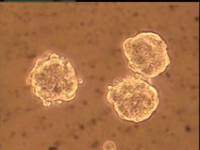
Cardiac arrhythmias are common diseases which include complex and multifactorial disorders of cardiac rhythm. Severe bradycardia (i.e. slowing of heart rate) and atrio-ventricular node block often require implantation of an electronic pacemaker as the only possible therapy. The aim of this project is to create a cellular substrate able to autonomously generate rhythmic, spontaneous activity and to act therefore as a “biological pacemakerâ€; the ultimate score of this project will be to use biological pacemakers instead of the electronic devices implanted today.
The approach is based on an in vitro differentiation of stem cells (embryonic or adult) towards a cardiac, pacemaker-like phenotype during which cells are driven to acquire a set of ion channels and other proteins necessary to generate spontaneous action potentials. The functional validation of the system includes: a) characterization of electrical properties of stem cell-derived cardiomyocytes (voltage- and current-clamp); b) analysis of ion channels and other sinoatrial proteins by RT-PCR, western blot, and confocal imaging; c) evaluation of the ability of these cells to modify and drive spontaneous activity of a primary ventricular cell culture.


